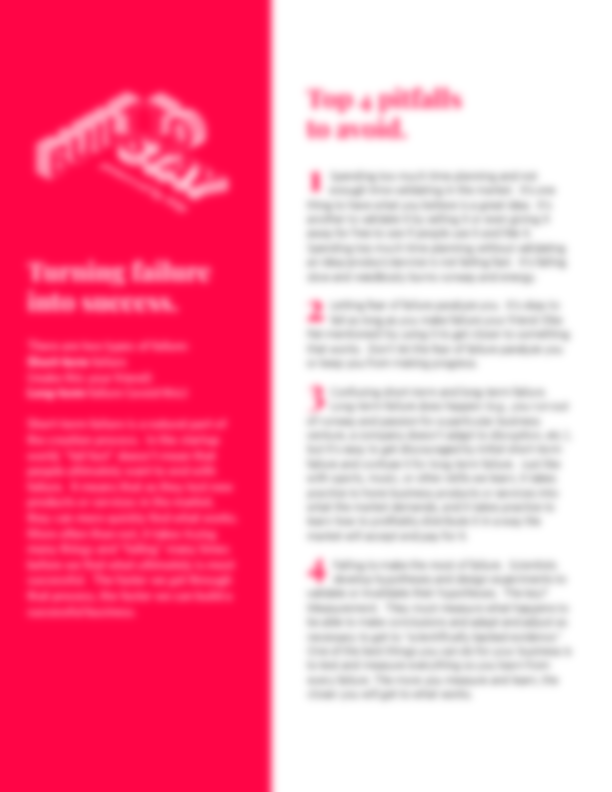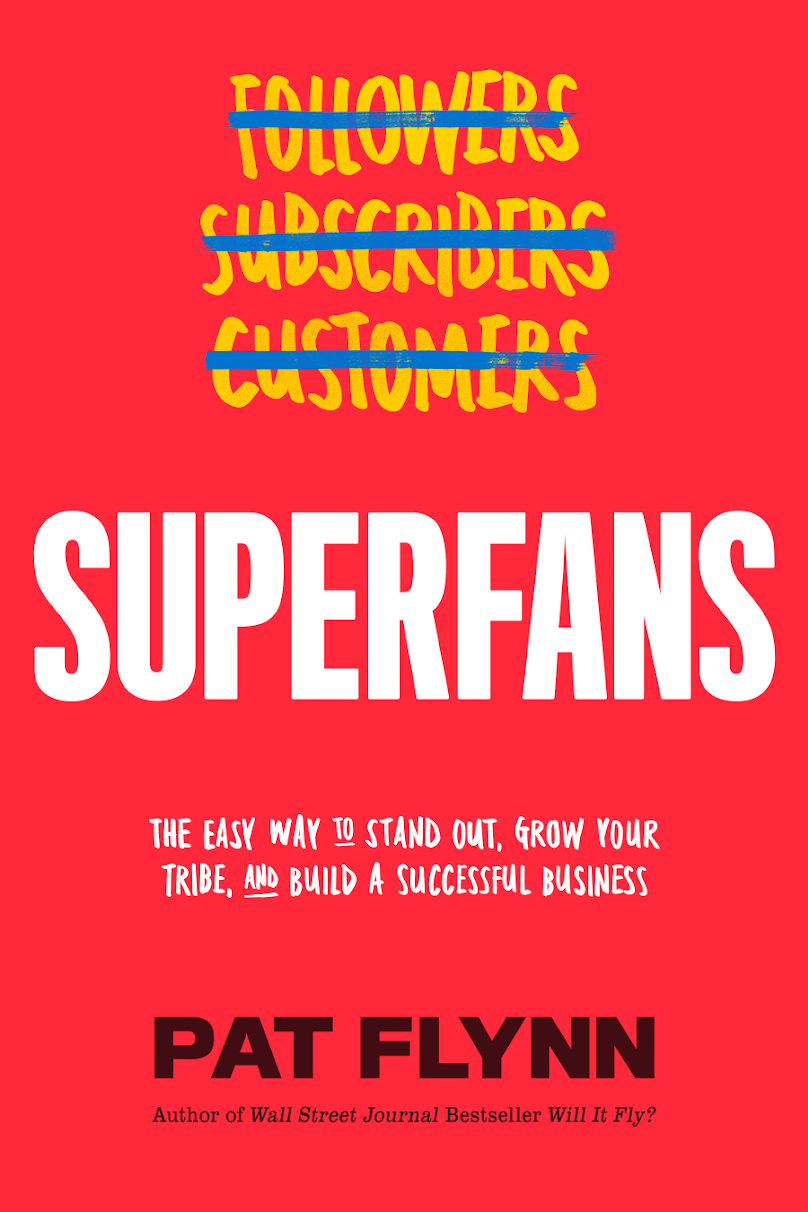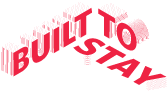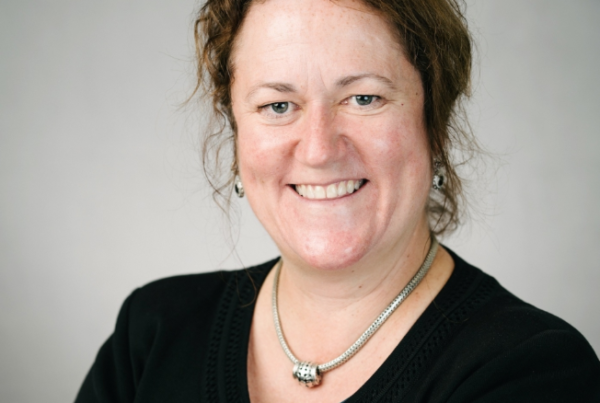Podcast Transcript
Bart: All right, Pat. Thanks so much for joining us. We’re super excited to have you here.
Pat: Thank you for having me.
Bart: Absolutely! Built to Stay is all about creating businesses with staying power something that will Outlast the competition and succeed over time. And as we all know there’s no better way to learn about success than by learning from its sibling failure. Pat, you’re clearly a very successful guy, but is it accurate to say you’re no stranger to failure as well or has everything always been super easy and successful for you?
Pat: The way I grew up interestingly enough, I lived in a very traditional home where it was all about grades and I would come home from school with a 97 percent on my test and my dad would ask what happened to the other three percent and we would spend hours. Just getting those questions, right? We’re not even really appreciating the 97% that I got correct but focusing on what I got wrong, so I grew up to understand that failure was bad. However, in being an entrepreneur and that started in 2008 after I got laid off from architecture with the recession at which point I thought I was a failure because I didn’t keep my job. I realized that that was that actually out of my control and I’ve seen realized that failure is what breeds success.
Failure is learning failure is part of the process and especially for business owners entrepreneurs like you have to fail and you look at the record of any successful entrepreneur, you’re going to find a record just as long if not longer of all of the failures and it’s not just entrepreneurship either.
It’s you know authors. I mean JK Rowling author of Harry Potter is very open with how many times that Harry Potter was rejected, you know, Stephen King’s books. And several others that are now very successful movies Back to the Future was rejected by movie studios 30 times or 40 times actually. Tim Ferriss his book The for the 4-Hour workweek was rejected 21 times before somebody finally gave him a chance. And so rejection failure not reaching the goals that you want all can help you if you let it if you want it to. And I had to grow out of an understanding that failure was bad and realizing that it can be used for good. It’s up to you to how to sort of interpret that failure and I’ve definitely had my fair share of failures for sure.
Bart: [00:02:25] There is a lot to unpack there. So back to you know, your parents focusing on the three percent rather than the 97 percent. How do you focus on failure in a way that you don’t focus on it too much, but you do learn from it and move forward?
Pat: [00:02:42] Yeah, I think it takes a level of understanding that number one, you should just be grateful that you actually had a chance right and be grateful for the things that you did do right because oftentimes and this is outside of test, right because tests are very binary. It’s like you either got an A B or C or whatever but with life and building businesses, usually, there are things that do go well and do not go well and often times those failures outweigh the things that actually did go well so much that we just think it was a complete failure. So number one is just being grateful for the things that actually did go right and appreciating that 97 percent and even if it’s 10% that you got right appreciating that and understanding “okay, well, at least I got that far, but what’s next?” And I think it takes a level of just, depending on how every individual treats failure, it might take a moment of just sort of breathing or just walking away for a little bit to come back and then start to tackle. Okay, like where do we go from here? And I think with failure, in the sense that at the way that I teach entrepreneurship, failure is a part of the process. It’s like it’s a step in the discovering process of “Okay, well, what does work?” So when it comes to building businesses, for example, number one, you just need to understand your target market and what their problems are and then hypothesize what various solutions might be and base your conversations, base your surveys, base your previous experiences to help you determine sort of okay, like this might be the next solution or next build or next software that we’re going to create and then go from there and then bring those and propose those to your prospects.
I did this very recently with a physical product that I just invented with my videographer. It’s a tripod called The Switch Pod. We launched it on Kickstarter and people only see the fact that we had 4800 backers and had made about a half million dollars in the go home and like success.
Bart: It’s so easy. Yeah.
Pat: It’s so easy right? Not actually because it took a year and a half of failure after failure prototype after prototype, material test after material test to get to that point where okay, here’s the final prototype that our audiences happy with and it has the strength test that we had wanted to and all that stuff and it’s a journey right? And that’s what people don’t see when and it’s partly the media’s fault, right? We always see and what gets highlighted are these sort of crazy success stories that are so few and far between but they make the media and they are on the news because they are so few and far between but we see that we base our success on theirs. And I think failure, also using that as a learning process, you got to remove the comparisons with others and I think that’s a that’s an important piece of this component that we often forget because when we go, oh man like I did the same thing and I failed but so-and-so succeeded, you’re not the same person. It’s not the same journey. But we often compare ourselves, you know Apples to Apples and go “well, we must not be as good’ when really it’s you’re completely different person on a completely different timeline and it’s at that point where you can make a decision to keep going and learn from those failures and actually start to break it down. I think you know, we’re learning from failures doesn’t mean just try the same thing again. Right. I think that’s called Insanity, by Einstein, but learning is understanding what didn’t go right and creating a new environment or trying a different thing or changing a variable such that the next time it might be better. And then what happens is okay, maybe it actually got worse. Okay. Well that variable not going to change. I’m going to bring that back and now I’m going to change this thing instead and it’s literally almost like a scientific process to help you discover. What will work and what doesn’t.
Bart: Yeah, that’s where I was going in my mind and it sounds like what you’re saying is sometimes people or businesses fail because of how they treat failure. Is that accurate? How they think of failure, how they deal with failure really in many ways predicts whether or not they fail at a larger level.
Pat: Yeah, it’s all the mental behind it. Right? It’s how you interpret it. It’s the story that you’re going to let failure create for you because failure can be oh, I’m not good about I’m not good at this, I’m going to stop. Another person who had the exact same failure could go, hey that didn’t go the way I expected. Let’s keep going and try again with these new learnings. It’s up to you to determine what you want to do with that failure and unfortunately, many people were raised like me and to consider that failure is bad in to avoid it at all costs. And this is from school right? Like big fat F on your paper means, hey, you’re not good at this don’t do it anymore. Versus a big fat F might mean, hey, you’re just you haven’t learned this stuff yet. Let’s see if we can get a D next time. Let’s even get a B the next time after that. And then maybe make your way up to an A. Failure might mean realizing that hey when you take that test, for analogy purposes and you get an F, maybe that just means hey, you know what? That’s not a skill that you’re very good at, therefore, you can use your skills as an entrepreneur to find people who can do that for you or to find software to do that for you because it’s not something that you’re good at. Part of being an entrepreneur is understanding what your weaknesses are just as much as what your superpowers are and to hire for those weaknesses. Versus what I used to do is trying to be the one-man band and try to be all the things in my business that I needed to do from designer to coder to writer to publisher. And it just you get so stretched thin versus what I know. I’m great at now, which is podcasting and building relationships. That’s all I do in my business now and that makes me really happy.
Bart: Absolutely and you do it very well. When it comes to looking at why businesses fail online when I searched that. I see a bunch of lists of the various reasons businesses fail, you know, the market wasn’t ready, the timing was off, the funding wasn’t there, they ran out of ramp. You know you don’t have enough money or time or resources available to keep going what you’re saying is a couple of things that I really like and let’s dive into this. Why do businesses fail question a little bit deeper? One is a lot of its mindset so you may fail in part because you just stop your mindset is focused on the failure and not on “Okay. What did I learn? How do I move on? How do I be successful in this or that area?” And the second is really that process of how to do that in a way that moves you forward similar to the scientific method. So Pat, tell me why do businesses fail?
Pat: I think most businesses fail before they even start. And I think that comes with a lot of the mental like you’re talking about. If you don’t believe that it’s possible, then it’s not going to work. Right? I think it was a Henry Ford who says if you think you can or you can’t, you’re right. And I think a lot of businesses fail because people don’t have the courage or they go in sort of halfway and not giving their business an actual chance because they aren’t committed to giving it a shot and that’s really what it’s about. Giving it a sho,t not going in so haphazardly such that if you succeed that’s the only thing that could happen and if you fail well, then you’ve not given it enough and you’re not going to feel as terrible. You need to comment and give it a chance. Right? And this is why I teach a lot of people how to podcast, right and they go “oh, I’m just going to try five episodes and let them be and just see if that works.” And I’m like, you’re not giving it a chance to work if that’s quote testing it. Like you’re not giving it a full chance to realize its full potential and thus you are already doomed, you’re already doomed. Secondly. It’s getting into a market that you haven’t done enough research in and just kind of going in guessing and I think that’s doomed from the start because there’s a great chance that you’re going to be either creating something that somebody else already did and you know, it’s going to be second at best. Or you’re going to create something that nobody actually needs which I’ve done before and I’ve wasted tens of thousands of dollars getting a little bit too excited about business ideas in the past and kind of rushing into it without doing research.
A very specific story was back in 2010 when a couple of buddies of mine, who were in completely different niches, but they both had WordPress websites and they each created WordPress plugins that they sold to their audiences. Their audiences were smaller than mine. And I was like hmm big opportunity here. I had dollar signs coming out of my eyes, which is the first mistake, by the way, when you do it just for money that’s never going to be a good sort of ending. I just immediately hired a developer. And I had an idea that I thought my audience would like, it was something that it was kind of I needed it too. And so I was like, okay, well everybody else must need it if I need it. Again, another mistake. And I paid this person, I think six thousand dollars for a project that was supposed to take five weeks. But because we rushed it and because I didn’t do my research and because I didn’t even know exactly what I wanted this to be, I just had an idea for what the final outcome would be. It took about 16 weeks. And about $15,000 and by the time it’s finished there are so many iterations. So many like I don’t know or if I think you should do nah, maybe not and just a lot of back and forth. And finally, it was at a point where I was like, okay, this is good enough.
So I shared it with a couple of friends and I shared it with a couple of my fans in my audience and I was like guys I got this really great thing to reveal to you. Here it is. And the response is just like meh I was like, what do you mean like I spent all this time and money on it. And honestly, that doesn’t matter to them how much time and money. Does this thing actually serve a purpose? Does this actually help me? And they were all saying like, yeah, this is kind of cool but there’s this other one that kind of does this already ooh, but maybe it should do this. Maybe you should do that. Oh, yeah, that would be great. And by this time I was like making a huge list of things I should have done and the number one thing that I should have done was, let people know about this ahead of time so I can have them poke holes in it before I did anything to build it because they would have told me immediately that this was a dumb idea. I got in this idea of trying to keep it a secret and let people know about it. I was doing something that I didn’t do any research in, so when I teach entrepreneurship, it’s all about the research up front.
I like to call it creating your Market map. And if you imagine like your business is like you’re in a plane right now and you’re kind of overseeing bird’s eye perspective of the land of the market that you’re getting into, you need to know where the runway is, what position to be in. Because you know, a lot of people go into business and they don’t even have a map. They’re just going in and going okay, I’m gonna build my product and then let everybody know about it and just hope for the best. Versus if you do a little bit of research up front to understand who are the major players there? What are the products already being offered in that space? Where do those people hang out? Where does that target audience exists online and offline? Just that exercise alone can give you some good perspective on, whoa, there’s just like land over here that nobody’s built on yet. But it seems to be something that people want. I’m going to go there. Or whoa, this is really crowded. Maybe I don’t want to go here because I don’t really have anything additional that I could offer here. I’m going to start with something else and then you’re immediately understanding information before you even get started that can help you make sure you’re going on in the right foot or not. So it’s that two-part process of number one, just the mental and sort of believing in yourself. And by the way doing the market map exercise and getting some confirmation from people and understanding where they are and seeing what they’re already buying, that’s going to help with your mental to in the confidence going into a space. But then also just understanding what you’re getting into and removing the guesswork really as much as possible is my other piece of advice.
Bart: You want to spend less to get to meh.
Pat: Right, right and really it’s like that Abraham Lincoln quote right If he’s going to chop down a tree, he’s going to spend the first six hours sharpening the axe and to me, that’s the research process.
Bart: So that makes me think there’s kind of a short-term aspect and a long-term aspect to success and failure. You know Built to Stay as a podcast, our focus is on how do you build for the long-term success, long-term profitability and not just be a flash in the pan. What I’m hearing is a lot of our failures whether personal or business really comes from, a perspective or mindset around what failure can do for you? There’s a process around learning from failure and moving forward. If you think about the short-term versus the long-term, long-term failure is probably a little bit more something that one you can avoid upfront, as you mentioned, but two, something that you really want to avoid, right? You don’t want big long-term failures you want to have a lot of short-term failures that lead you quickly to success so that you can have that long-term success.
Pat: That’s a really great perspective. I like that and those failures that happen on the long-term are different, right? It’s not necessarily like a single project failure. A project failure could teach you what the next project should be versus a long-term failure of your business like it’s going out of control and it becomes a cash eating monster. Well, now your businesses fail because you’ve just gotten so jaded with creating so many products and spending all that money and not remembering sort of why you’re getting into business in the first place and that owns happened with Lego. Lego back in 2013 was 800 million dollars in debt. That’s crazy, like almost a billion dollars in debt, but they turn it around because they stopped they were producing just so many products and spending so much money and they went back to fans after that and go. Hey, let’s build for our fans again. Let’s get our fans involved and let’s get them involved in the process and they started to create things that actually people wanted which is where you saw a lot of the licensing deals with movies and TV shows and you know games and things like that at all started come out into play when they started asking their fans what they wanted. And now they’re a hundred and fifty billion dollar company worth more than Hasbro and Mattel combined. It’s pretty amazing, like the shift in how quickly, but it almost fail because it was a cash eating monster at that point. Another long term failure could be the systems, right? You as a CEO getting burnt out. In the beginning, maybe it’s all you because you’re bootstrapping but as your business continues to grow and your attention, begins to be asked for more and as you have bigger things to think about, if you continue to do a lot of those little things, you know, you only have 24 hours in the day and you need to get some sleep. I mean you’re going to burn out and a lot of my good friends have experienced that and that could lead to ultimate failure. First of all, you can learn from that obviously, but if you’re exhausted and you’re losing customer support because you’re just aren’t there anymore and mentally you’re just exhausted well, your business is doomed. And when it comes to especially online businesses, it can be very quick for people to spread the word about how terrible your customer service support is right, and that stuff spreads pretty quickly. So I mean there’s a lot of long-term failures that happen with really the long-term goals and a lot of the goals being lost sometimes. It’s funny because on the sort of solopreneur bootstrapping a lot of people get into business themselves because they want to have freedom. But then what ends up happening is their business takes up more time than they were spending in their nine to five. And it’s just really interesting on that micro level and then on the macro level, you know, your business can grow out of control or you can be persuaded by things that maybe aren’t in the core mission that you have and I think that that comes down to you know, a lot of very successful businesses have core values and mission statements that they actually support and that any decisions that are made, can only be made if it falls in alignment with those values. Versus a lot of businesses that might kind of haphazardly sort of build and create and kind of go one direction then go another direction. It’s hard to be a fan of that and for me super fans, related to my next book, is really important because that what going to help you avoid failure because your superfans are going to be the people who no matter what happens to technology, no matter if your email list gets hacked or your website gets hacked like your superfans are going to follow you no matter what. And they’re also going to be, and I’ve experienced this, they’re going to be the people who are going to guide you back onto the rails when you start to fall off and that’s why this book is really important to me in the message of super fans and building for that because that to me is the ultimate way to build long term success and essentially create long-term insurance for your businesses to have those super fans who even if the team is 0-16, they’re still going to show up to the game. Right? And that’s how you can still support a losing team if you happen to be going through a dry spell.
Bart: [ Well, I really like that you tie this in with super fans. You know, your first book, Will it Fly, was really all about that testing in the short run and learning from failures, doing the right research, all that kind of thing so that you can build the right business from the get-go and it sets you up in the long-term to be successful, but ultimately like you say, how do you avoid burnout? How do you prevent the kind of mistakes that we can all make if we lose sight of things and that’s really providing value to customers over the long-term getting super fans that you can work with and you know that are your Super Fan over time. I haven’t read the book yet. I’m excited because it’s launching in August, but, you know, it seemed like you were the perfect guests to have on Built to Stay to talk about why do businesses fail, well one in the short term they failed to, you know, start the right way and two, in the long term they fail to remember that ultimately you’re there as a business to provide value and who do you provide value to? Your customers, your fans, your super fans, right?
Pat: Totally. I mean it reminds me of this story that went viral couple weeks ago. I don’t know if you saw it Bart, but it was just a person who had an Instagram account of two million people, that’s its huge, massive and she tried to sell t-shirts and she was very open but got a lot of flack for this she was like, I have two million subscribers and I was only able to sell 26 t-shirts like what’s what’s going on. It just became this big lesson for everybody. And this is another thing, we get lost in the vanity metrics and I think a lot of businesses fail when yes on the surface and on paper things might look good, but if you aren’t providing those experiences and you’re not really making a connection with the people who you’re trying to serve, I mean who cares if you have 2 million followers, nobody’s gonna buy anything if you don’t understand them. That doesn’t mean anything. And I can imagine an Instagram account with a hundred followers who tries to sell a T-shirt and they sell 200 because each of their fans wants one, but then they buy one for their friend too. And that’s the kind of business that’s going to give you long-term success. It’s not about the vanity numbers doesn’t like getting more followers and all that stuff is important like you want to grow, they’re indicators. But if you’re not making real connections, then it’s kind of all for nothing.
Bart: Yeah, absolutely. Well, thanks for taking the time to share your experience and insights with us, Pat. Builders, you can find more from Pat on his podcast Smart Passive Income and Ask Pat or his website smartpassiveincome.com. I’m personally very excited about the launch of his new book Super Fans, which you can pre-order now, it’ll be available August 13th. Links to all of the above are in our show notes on our website builttostay.com.
Podcast Resources
Join our email list to download Turning Failure into Success document.

Will It Fly? Course here




